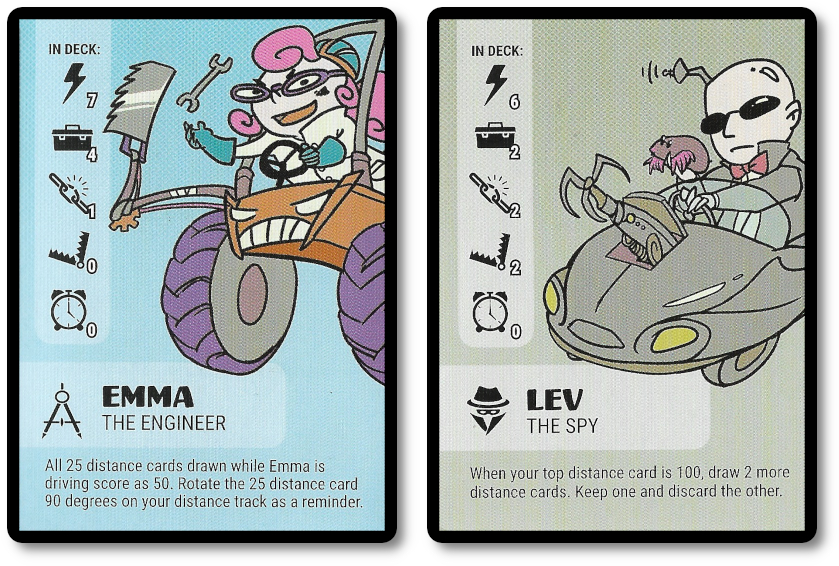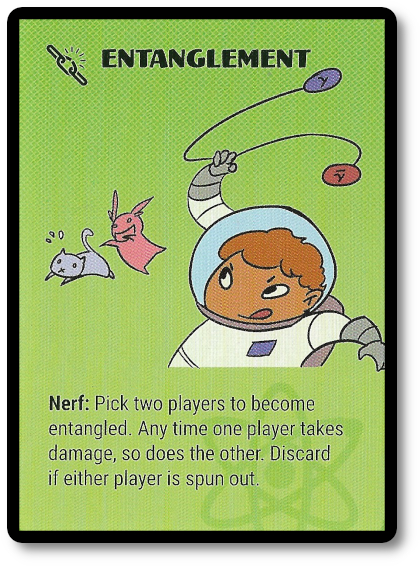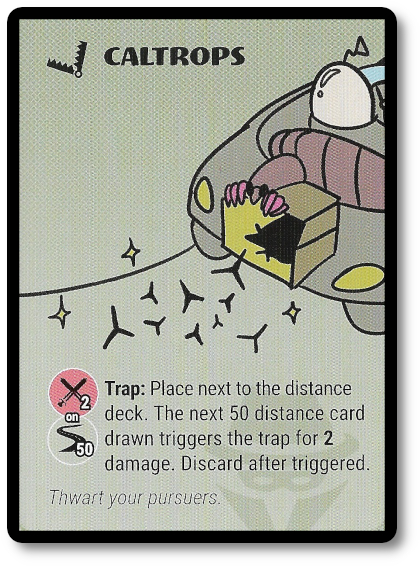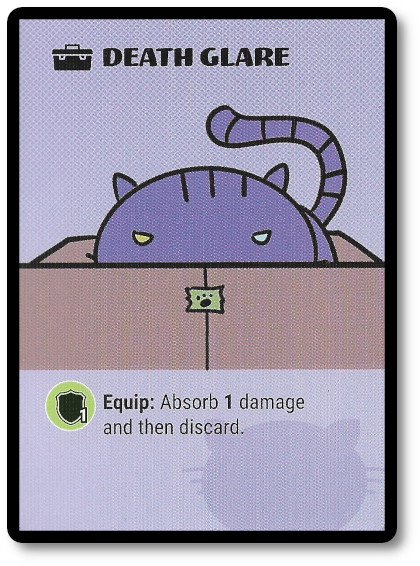
The Basics:
- For ages 8 and up (publisher suggests 13+)
- For 2 to 4 players
- Approximately 30 minutes to complete
Geek Skills:
- Active Listening & Communication
- Counting & Math
- Logical & Critical Decision Making
- Reading
- Strategy & Tactics
- Risk vs. Reward
- Hand/Resource Management
Learning Curve:
- Child – Easy
- Adult – Easy
Theme & Narrative:
- A race with a bunch of unruly drivers
Endorsements:
- Gamer Geek rejected!
- Parent Geek mixed!
- Child Geek approved!
Overview
Former American professional stock car racing driver, Jeff Gordon, said, “I think fear is what keeps us from going over the edge. I mean, as a race car driver, I don’t think what makes a good race car driver is a fearless person. I think it’s somebody comfortable being behind the wheel of something that’s somewhat out of control.” In this game, control is an illusion. You can equip your vehicle for speed, throw down traps to slow down your opponent, and even sabotage an engine or two. In the end, what will win the race is random lucky outcomes and close calls.
Shuffle Grand Prix, designed by Rob Newton and published by Bicycle, is comprised of 50 Distance cards, eight Driver cards, four Tire Health cards, eight Turn Tracker cards, four Reference cards, and 16 Trophy tokens. The cards are as thick and as durable as your standard playing card. The Trophy tokens are made of thick cardboard. Artwork by Ruwen Liu is cartoonish and colorful, giving the game a lighthearted feel.
Prepping for the Big Race
To set up the game, first give each player one Tire Health card, two Turn Tracker cards, and one Reference card. Place any of these cards not used back in the game box.
Second, shuffle the Distance cards and deal one to each player, face-up. Place the remaining cards face down to create the Distance draw deck.
Third, starting with the player who was dealt the highest valued Distance card and continuing clockwise, each player selects one Driver card and their corresponding Ability cards. When the last player selects their first Driver, they will then choose immediately their second. Driver selection then continues in reverse order (with the first player to choose their Driver to be the last to choose their latter).
Fourth, all players now set up their Car by placing their Tire Health card in front of them and then placing one of their two Drivers on top of it, indicating a total of four Tire Health points. The Driver not selected is considered the “co-pilot” and is placed underneath the Tire Health card at this time.
Fifth, all players take the Ability cards of the two Drivers they selected and shuffle them together. The deck is placed face-down next to the player when done. This is the player’s Ability to draw deck for the duration of the game. All players now draw the top three cards from their Ability draw decks to create their starting hand.
Sixth, reshuffle the Distance deck (if needed) and place it face-down in the middle of the playing area, along with the Trophies.
That’s it for the game set up. Time to get racing!
Drivers Education 101
Shuffle Grand Prix is a game that simulates a race. And like real racing, where there are vehicles and a lot of speed, there are also larger than life personalities. The Driver cards represent these. Each Driver is unique, with their background and individual ability. Each driver also comes with their unique deck of Ability cards that are tailored both thematically and mechanically to the driver’s personality. This means that each player in the game will be engaged in the same race, but will have different options.

During the game, the player gets to use two Drivers. The active driver is referred to as the “Driver.” Their unique ability is considered “active”. The other Driver is referred to as the “Co-Pilot.” This driver is not active until the player’s Driver spins out. At this point, the Co-Pilot becomes the active driver.
Drivers! Start Your Engines!
Grand Prix Shuffle is played in turns with no set number of turns per game. A player’s turn is summarized here. While the majority of the player’s choices will be completed on their turn, there are cards in the game that can be played at any time to counter an opponent’s actions.

Step One: Go the Distance
The player’s first step during their turn is to draw a Distance card, placing it in front of them. Distance cards track the driver’s total distance completed so far as of the player’s turn. Each of the Distance cards lists the distance value (25, 50, 75, and 100). As the game continues, the player will have a row of Distance cards in front of them, growing ever longer.

Step Two: Update Abilities
If the player has any Ability cards in play that are activated when it’s the player’s turn, they now rotate the Ability card.
Step Three: Play Ability Cards, Requip, and Take a Break
The player now has several choices, but only one of their choices can be taken on their turn.
Choice One: Play Ability Card
Ability cards come in three different types. These are “Actions,” “Nerfs,” and “Traps.”
“Action” Ability cards give the player a one-time boost or bonus.

“Nerf” Ability cards slow the player’s opponents down, causing confusion and delay.

“Trap” Ability cards are meant to create havoc for the player’s opponents, but they can also be triggered and impact the player’s driving, as well.

Choice Two: Requip
Each player’s Driver card can have up to (but no more than) two Equipment cards attached to it. And there they will remain until triggered (often resulting in the Equipment card being discarded) or replaced. The player can place one Equipment card directly to their Driver card on their turn as long as they have one or no Equipment cards currently in play.

Choice Three: Hit the Pit Stop
If the player does have two Equipment cards in play on their Driver card, the only way to remove them is to make a Pit Stop. When they do, they can swap any of their cards currently in play on their Driver card with any single other card from their hand. The removed card goes back to the player’s hand, not the discard pile. However, due to stopping for a quick break, the player must now take the top-most Distance card they have in play and discard it.
Choice Four: Discard and Draw
The player may select any card from their hand and discard it. They then draw a new card, replacing it.
Choice Five: Pass
If none of the other choices sound like they would help win the race, the player is always welcome to pass on making a choice. Which is a choice. How’s that for ironic?
Step Four: Spend Those Trophies
Trophies in the game are more than just bling to put on your shelf and brag about to your friends at barbeques. They give the player additional actions on their turn. This is done by “spending” the Trophies previously won, returning them to the pool of Trophies in the middle of the playing area.
- Spend one Trophy to swap Drivers (primary Driver becomes the co-pilot and vice versa)
- Spend two Trophies to play an additional Ability card
Spinning Out
As the game progresses, a player’s Driver can take damage to their vehicle. Specifically to their tires. Damage is tracked by using the Tire Health card. Each time a player takes damage, the Tire Health card is rotated. When the player’s tire’s total health is reduced to zero, they have a spectacular blowout, and their vehicle spins out of control. Luckily for everyone, the driver is perfectly fine! Unlucky for the player, they will suffer a few consequences.
- All equipped cards on the Driver card are discarded
- All cards in the player’s hand are discarded
- All “Nerf” Action cards played against the Driver are returned to their owning player and discarded
- The top-most Distance card they have in play is discarded
The player now takes control of their Co-Pilot, swapping out the Driver cards. The Tire Health card is reset, and the new Driver is immune to all actions until the player’s next turn. Which is to say, they cannot be targeted by an opponent…yet.
Winning Trophies
Trophies are earned when actions are taken resulting in a player’s opponents spinning out. Funny enough, more than one player can assist in the spin-out, meaning that one or more players can earn a Trophy token as the result of one opponent losing control of their vehicle. Also, it’s possible for a player to accidentally sabotage their car due to reckless driving or springing their trap. If this occurs, they are responsible for their spin-out, which rewards the player a Trophy token, as well.
A bit of a warning here. Due to just about everyone getting a trophy, even as a reward for not doing well, you should expect a few players to get snarky about it. The world is big enough for everyone to have an opinion, so don’t get too salty. I do suggest you educate yourself on the premise of the conversation, though. Read this article on the pros and cons of participation trophies.
Crossing the Finish Line
The game continues as described above until the last Distance card is drawn. The player who drew the previous Distance card completes all the steps in their turn. Once their turn is over, all players add the values of the Distance cards they drew and still have in play. The player who has the highest Distance value wins the game.
Final Word
 The Child Geeks enjoyed themselves, often stating that the game reminded them of various video games that also involve a lot of shenanigans on the track. According to one Child Geek, “I like the game because your focus isn’t really on the racing. It’s all about making the other players go slower.” Another Child Geek said, “The only part about the game I don’t like it when my friends make my car spin out. But I love it when I make them spin out!” This is a game in which the Child Geeks fully understood that the “race” element of the game was more about beating their friends and family to the punchline rather than the finish line. The result was a clear winner, according to the Child Geeks, resulting in Shuffle Grand Prix getting first prize.
The Child Geeks enjoyed themselves, often stating that the game reminded them of various video games that also involve a lot of shenanigans on the track. According to one Child Geek, “I like the game because your focus isn’t really on the racing. It’s all about making the other players go slower.” Another Child Geek said, “The only part about the game I don’t like it when my friends make my car spin out. But I love it when I make them spin out!” This is a game in which the Child Geeks fully understood that the “race” element of the game was more about beating their friends and family to the punchline rather than the finish line. The result was a clear winner, according to the Child Geeks, resulting in Shuffle Grand Prix getting first prize.
 The Parent Geeks enjoyed the game and believed it to be the right mix of random outcomes and silly choices. According to one Parent Geek, “I like how each player has a different driver and comes at the game slightly different than the rest. This gave the game replayability and variety. The only aspect of the game I didn’t like is the random distance draws. It doesn’t matter if you are the smartest or craftiest player. If you draw poorly, you cannot win.” Another Parent Geek said, “The game can run away from you, but I guess it all depends if you want to win or not. I didn’t care and just had fun, causing havoc. I didn’t have the most distance at the end, but I think I got the most out of the game.” When the last vehicle limped across the finish line, the Parent Geeks gave Shuffle Grand Prix a solid second place, resulting in a mixed endorsement.
The Parent Geeks enjoyed the game and believed it to be the right mix of random outcomes and silly choices. According to one Parent Geek, “I like how each player has a different driver and comes at the game slightly different than the rest. This gave the game replayability and variety. The only aspect of the game I didn’t like is the random distance draws. It doesn’t matter if you are the smartest or craftiest player. If you draw poorly, you cannot win.” Another Parent Geek said, “The game can run away from you, but I guess it all depends if you want to win or not. I didn’t care and just had fun, causing havoc. I didn’t have the most distance at the end, but I think I got the most out of the game.” When the last vehicle limped across the finish line, the Parent Geeks gave Shuffle Grand Prix a solid second place, resulting in a mixed endorsement.
 The Gamer Geeks didn’t much care for the game, finding it to be funny with some interesting ideas, but the way you won the game was considered absolute junk. According to one Gamer Geek, “A game you win only due to random outcomes is worthless, in my opinion. I should be able to win a game – especially a racing game – because of strategy and tactics. Not because of random distance draws. The impact other players have on my car is minimal compared to how devastating a poor draw from the Distance deck is.” Another Gamer Geek said, “A fun game for the family and I can see playing this with casual gamers, but I don’t think it would work well or keep the interest of the elitists. Too much randomness and not enough depth to make it a game a gamer would want.” The checker flagged flew for the last time and the Gamer Geeks gave Shuffle Grand Prix last place, resulting in total rejection.
The Gamer Geeks didn’t much care for the game, finding it to be funny with some interesting ideas, but the way you won the game was considered absolute junk. According to one Gamer Geek, “A game you win only due to random outcomes is worthless, in my opinion. I should be able to win a game – especially a racing game – because of strategy and tactics. Not because of random distance draws. The impact other players have on my car is minimal compared to how devastating a poor draw from the Distance deck is.” Another Gamer Geek said, “A fun game for the family and I can see playing this with casual gamers, but I don’t think it would work well or keep the interest of the elitists. Too much randomness and not enough depth to make it a game a gamer would want.” The checker flagged flew for the last time and the Gamer Geeks gave Shuffle Grand Prix last place, resulting in total rejection.
 Shuffle Grand Prix is a fun and light-hearted game. I like how the drivers are unique, and there is enough replayability to keep the game fresh. There are also enough choices in the game to keep the player’s mind occupied, as well as options to tag-team and even sabotage yourself. Lots of little jokes, eye-rolling, evil laughter, and disgusted sighs filled the air while we played. Made for a fun table with some entertaining conversation, as well as exciting trash talk.
Shuffle Grand Prix is a fun and light-hearted game. I like how the drivers are unique, and there is enough replayability to keep the game fresh. There are also enough choices in the game to keep the player’s mind occupied, as well as options to tag-team and even sabotage yourself. Lots of little jokes, eye-rolling, evil laughter, and disgusted sighs filled the air while we played. Made for a fun table with some entertaining conversation, as well as exciting trash talk.
Where the game spectacularly fails, however, is in how you win which is based on luck alone. I’ve seen terrible players win, and outstanding players lose all because of the Distance cards they drew. Yes, you do lose Distance cards as a penalty when you spin-out or make a pit-stop, but this is not a real game-changer. Especially if the top-most Distance card to be discarded is of little value. The game could have improved if the distance was universal. For example, five Distance cards you collect are of the same distance value as an opponent who received the same number of Distance cards. Smart plays reward a new draw of a Distance card, thematically suggesting the player’s driver is getting ahead. Better yet, make each Distance card drawn have some impact on the game. Introduce weather or a random event that triggers the players needing to make a choice — lots of ways to improve it.
However, this is not that kind of game. That’s not what the game designer was going for, and it’s near impossible to please everyone. What the designer did was give us a game with wacky choices and random outcomes, which is just fine within the limited scope of what the game intended. Not a bad thing by any means, just not a game that rewards the player who thinks the deepest and longest. Do give this game a try if you are looking for a lighthearted race game where the real goal is causing mischief.
This game was given to Father Geek as a review copy. Father Geek was not paid, bribed, wined, dined, or threatened in vain hopes of influencing this review. Such is the statuesque and legendary integrity of Father Geek.



